Beginning Your Art Adventures
I’ve mentioned in previous posts that much of my early watercolors were small paintings – no bigger than 4×6 or 5×7.
I thought if I worked tiny, I could finish sooner – and make another, and another, which would help me learn faster.
(Second career, getting older, I’m in a hurry – those were the thoughts percolating under my Becoming an Artist goals.)
I still love painting small, for a whole pile of reasons, so here are ten of them.
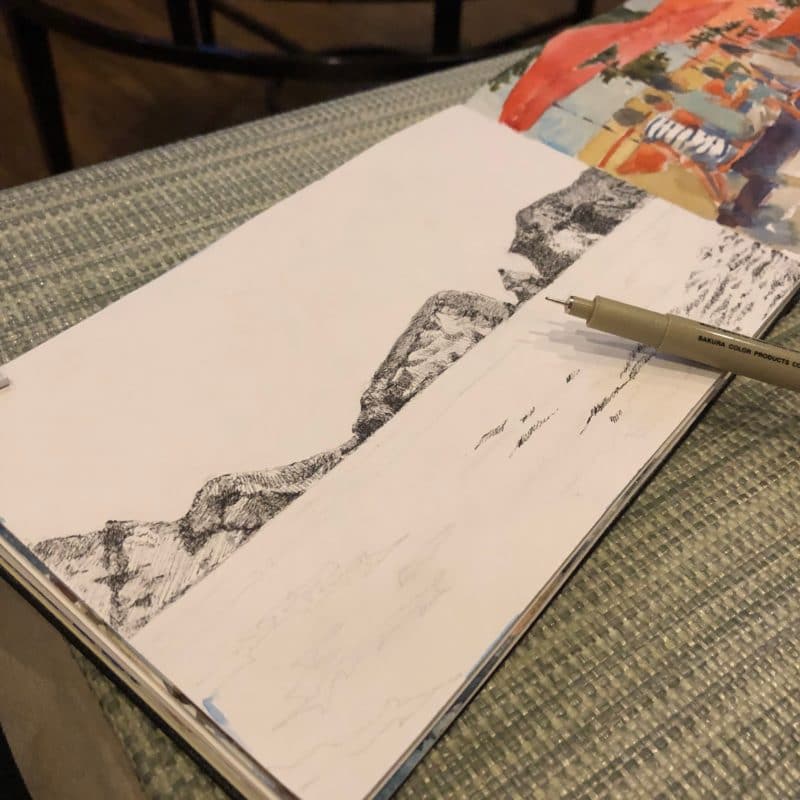

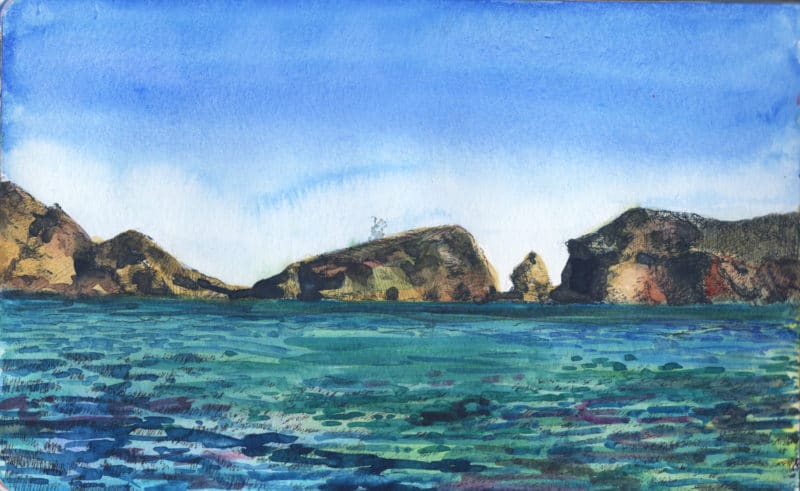
Painting Where You Live
There’s a chain of Islands off the coast of the town I live in. The coves and anchorages around the circumference of each island each have names. Some are based on geographical features – like Keyhole Rock (see below) – and others are named after the history of the place.
There is a popular anchorage on Anacapa Island island called Frenchy’s, named after a hermit who enjoyed company.
Anacapa is the closest island to us, so we went out to have lunch in Frenchy’s Cove on Mother’s Day, and I snapped a bunch of photos for some of the pen and ink and watercolor studies in this post.
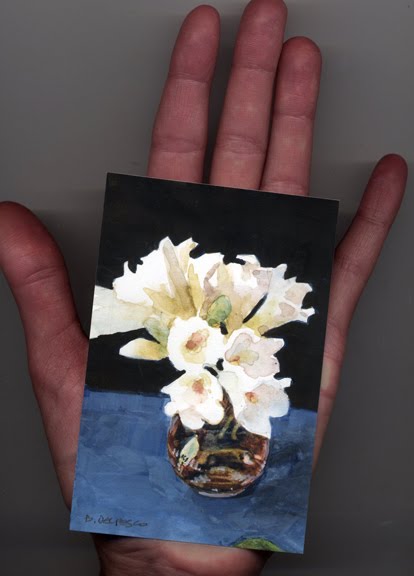
11 Reasons for Beginners to Make Small Art
- 1) You don’t need a big space to paint small. Work at your kitchen table or in a chair/on a couch with a lap desk.
- 2) Painting small allows you to finish sooner than you would with large pieces, so if you’re propelled to keep going via accomplishment – that’s a plus.
- 3) Small paintings require less paint and paper, so if your budget is tight, you’ll get more art from limited supplies.
- 4) You’ve spent weeks of work on a large painting, and it’s just not singing your song? It’s hard to throw in the towel and start over because you’ve put so much time (and paint) into it. On a 5×7 that’s just not flying, cut it up into bookmarks for your friends, and begin again.
- 5) Storing ten large paintings vs ten 5×7’s = the need for garage shelving vs a folder in your studio file cabinet.
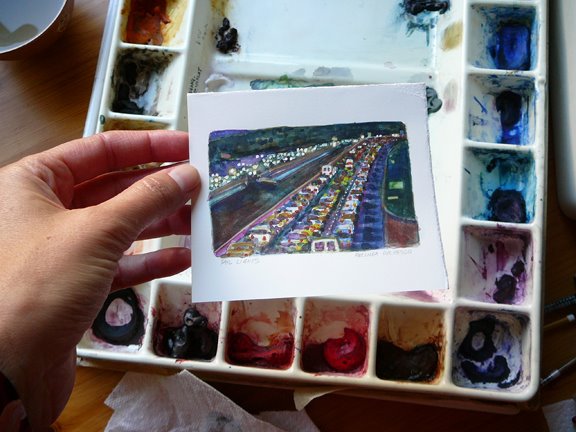
Eleven Reasons to Paint Small, continued…
- 6) If you’re new to sharing work online (website, blog, social, etc.) – scanning art that fits on a standard scan bed doesn’t require photoshop skills to stitch the high resolution scan segments of a large painting together. Just lay the art on the scan bed, title it, and press the scan button. Done.
- 7) Price points for smaller art are lower than large paintings. Sales on petite art may happen sooner and more frequently, especially with supportive friends and family. Regular sales as a beginner let’s you find your stride with the transaction part of being an artist; invoicing, taxes, shipping costs, packing, inventory tracking, etc.
- 8) Shipping small art – even when framed – is *so much simpler* and less spendy than packing and shipping large art. Trust me on this.
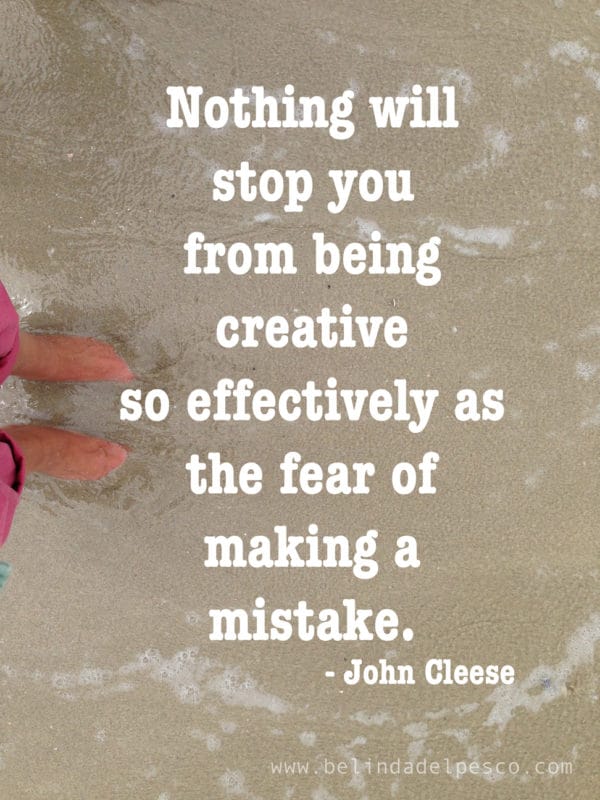
Painting Small – Reasons you Should, continued…
- 9) Do you know art collectors with no room left on their walls ? It’s easier to squeeze in Just One More when art is little because #wewillfindaplaceforthat
- 10) Small paintings work well as a beginner artist’s “test bed” to find your style and subject. Try painting small still life, landscape, genre scenes, etc. and then lay them all out. With a cup of tea, and a notepad, gaze at your work and ponder where you had the most fun and the biggest leaps forward.
- 11) That description above – laying all your little paintings out in a grid on the floor of your studio is a testimonial of your conviction to paint, and it’s a tiled grid of little art cheerleaders rah-rahing you for all the fun you had with your paints. Working on two large pieces you wrestled over a two month period might feel accomplished to stare at, but I bet you a dollar you’ll learn more about how much fun you had, what you learned, and which style and subject you like better with a grid of 20 small paintings in front of you!
- 12) Bonus – read what painter extraordinaire James Gurney said when a blog reader asked him why he works so small so often.
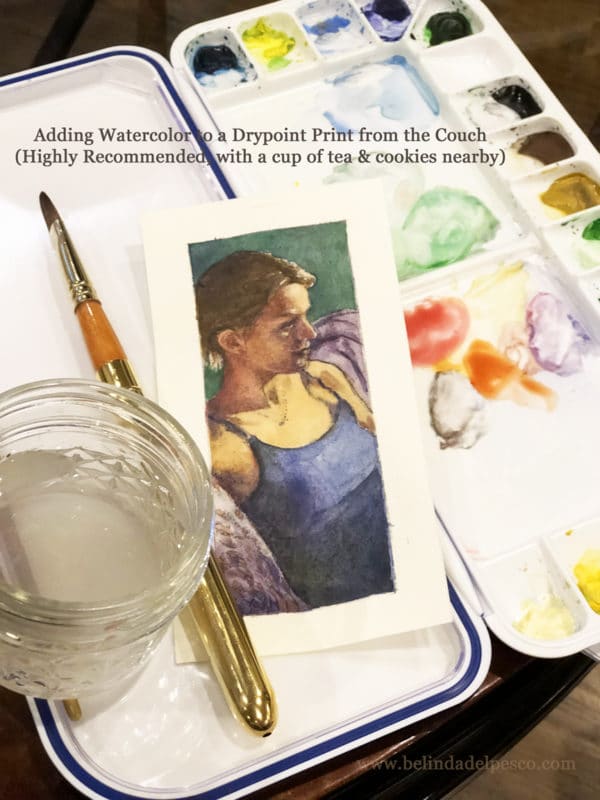
Art Links for You
- If you plan to start an email list of friends, family and fellow artists and art-lovers, the good folks at mailchimp have a very simple (and free) mail list option called TinyLetter. It’s a personal newsletter service without the business features associated with more complex, paid-for email management programs. You simply write and send.
- Speaking of newsletters, Sarah Benning is an embroidery artist I follow, and she just posted a fresh newsletter with upcoming embroidery workshops. If you like stitching, grab a friend or two, and attend one of her embroidery workshops.
- Over on my Instagram account, I had a great comment volley with another artist about being a noticer; are we noticers because we became artists, or are artists born as natural noticers? The next day, I got the wonderful Gretchen Rubin‘s blog post in my inbox about noticers! (Have you taken her Four Tendencies Quiz? Which are you?) Gretchen interviewed Rob Walker about his new book The Art of Noticing. Read the interview here.
- Alexis Franklin is a 23 year old artist who makes beguiling digital portraits using photoshop and a tablet, and she shares the recording of her brush strokes from start to finish. Here is an example from her YouTube Channel titled Youth. Watch it full screen so you can see her brush strokes clearly. Even though it’s a digital painting, the construction of the figure, the adjustments throughout the process, and the transformation from broad strokes of sketchy color to a fully realized portrait are mesmerizing .
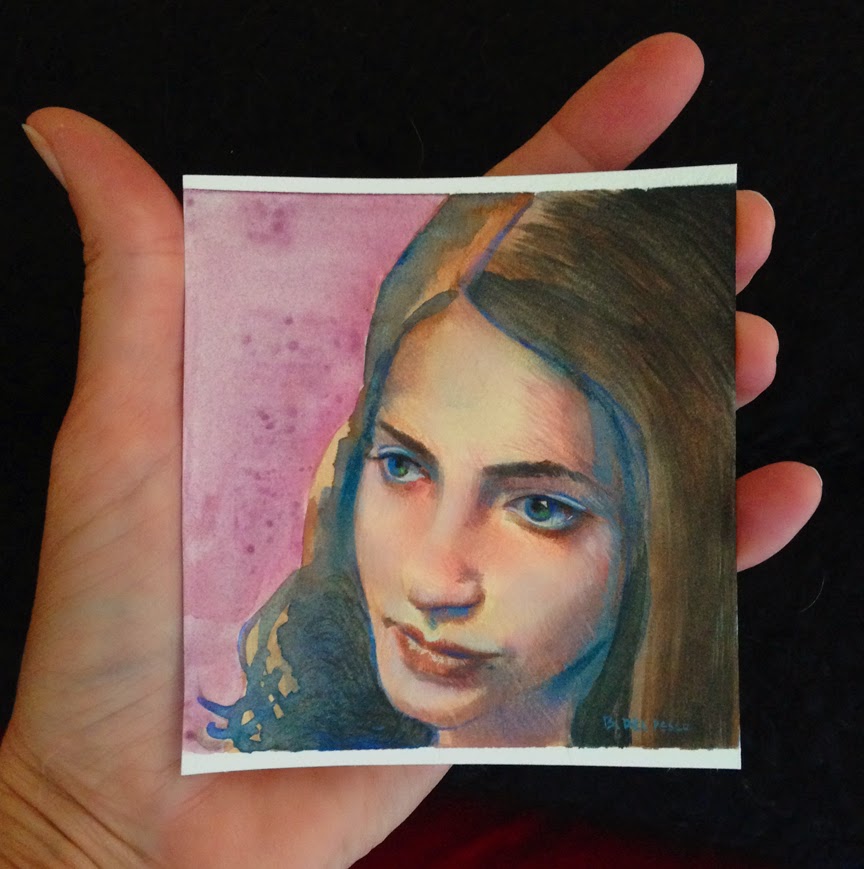
The Lasting Effects of Face-to-Face Time
Yesterday, my brother Robin and I drove up to Central California to have lunch with my step dad.
All three of us are busy, so we don’t see each other regularly, and rarely all together. It was good to have a long car drive to talk with my bro, and even better to sit around a table with Tom over lunch and catch up on each other’s particulars.
Face to face time often gets replaced with emails, social media comments and text communication.
Those digital connectors are great. I don’t knock them. It’s just that checking in digitally isn’t as rich as the volley of face-to-face conversation. All the familiar nuance of carriage, eye contact, inflection, and the un-namable, almost tribal sensation of feeling another’s physical presence in close proximity is how real connection is built.
Take opportunities to hang out with your peeps. Even for just a few hours. You’ll bring those conversations home with you, and ponder them more deeply in the days following your visit while your hands are busy making art. Consider contact with folks you love as another fuel source for your creativity.
Thanks for stopping in, and I’ll see you in the next post –
Belinda
P.S. You’re welcome to subscribe to this blog, so each post will land in your email inbox.
P.P.S. The electric pencil sharpener I use in my studio cost me $60 several years ago, and it was worth every penny. I noticed that Amazon has it on sale for 50% off right now, so grab one if you need a good electric sharpener.
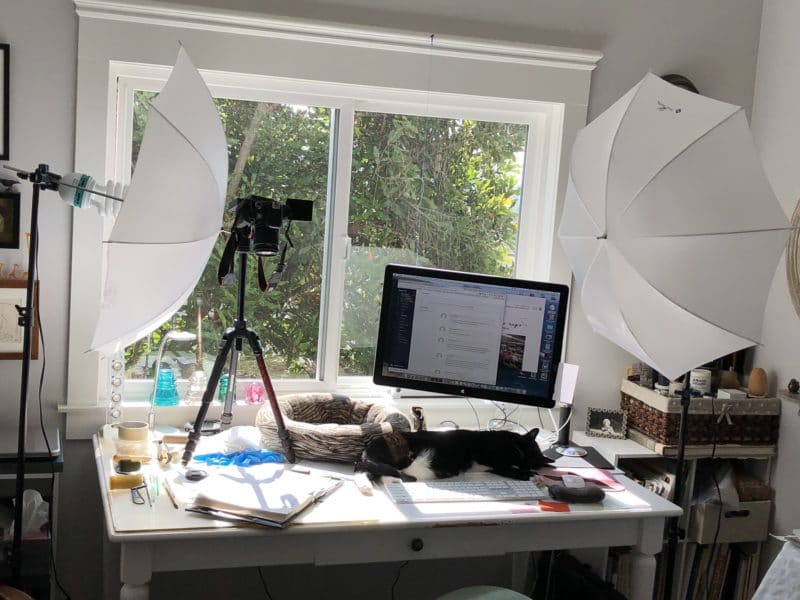
Art Quote
The relationship between purpose and pain also implies that pain is an important ingredient in our personal and professional development. Today’s leaders often struggle to let their employees make mistakes and experience discomfort. For example, I know many new managers who got far more serious about refining their interviewing process after making a bad hiring decision. It was a necessary part of their development and a learning they will likely carry with them throughout their career.
The tragedy of this avoidance of discomfort and pain is that it’s ultimately robbing the person of experiences that could lead to their greatest transformation and discovery of their core purpose.
Robert Glazer

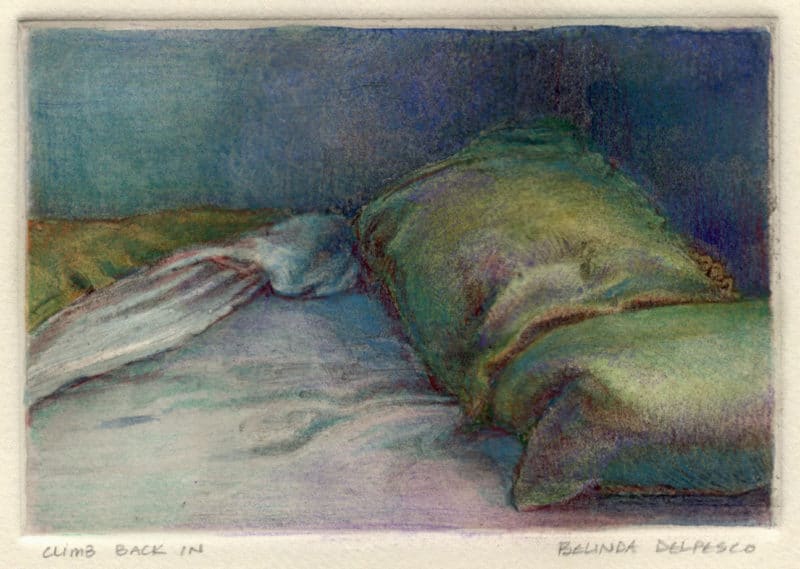
Hi Mary, Thanks for that compliment, and I agree – even the mundane can be made beautiful with pigments and a little imagination. Happy painting!
Love the traffic!! Just gorgeous …. everything can be beautiful – yes!
Beautiful portrait with the pink background.So amazingly thoughtful,fresh,yet mysterious!
Hi Katerine – Thanks so much for your compliments. Mysterious isn’t something I’ve considered, so I’ll look at the little face with new eyes! 🙂
Great post Belinda!
Which brand of soft lights, and lightbulbs are you using?
It looks great and compact for your area..
Hello Mariette, I have the LimoStudio soft lights and bulbs. They were incredibly reasonable, and I’ve been using them without fail for 6 years now. Highly recommended: https://amzn.to/2Hiqufo
Great post! Thanks Belinda!
Thanks, Patrick! I appreciate your visit. 🙂